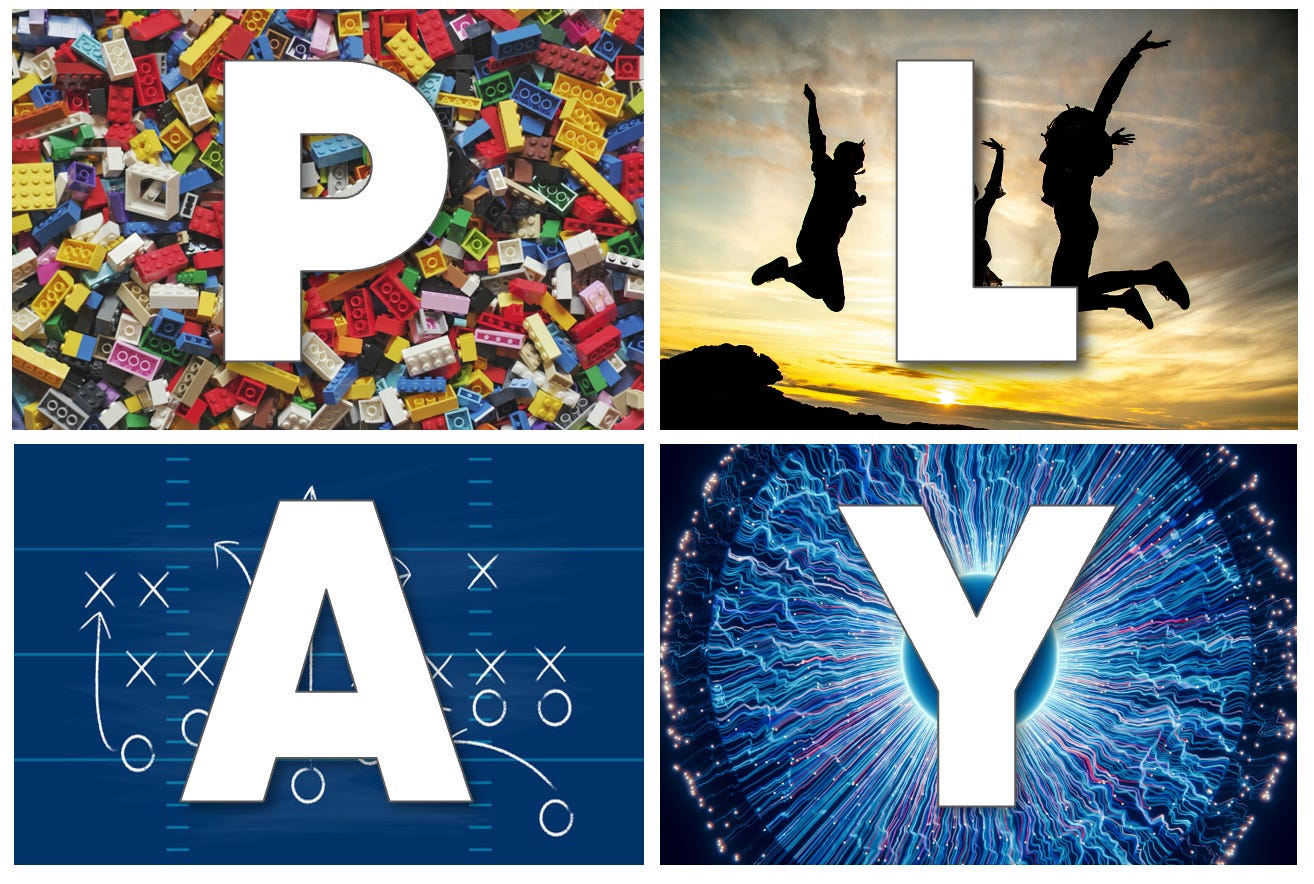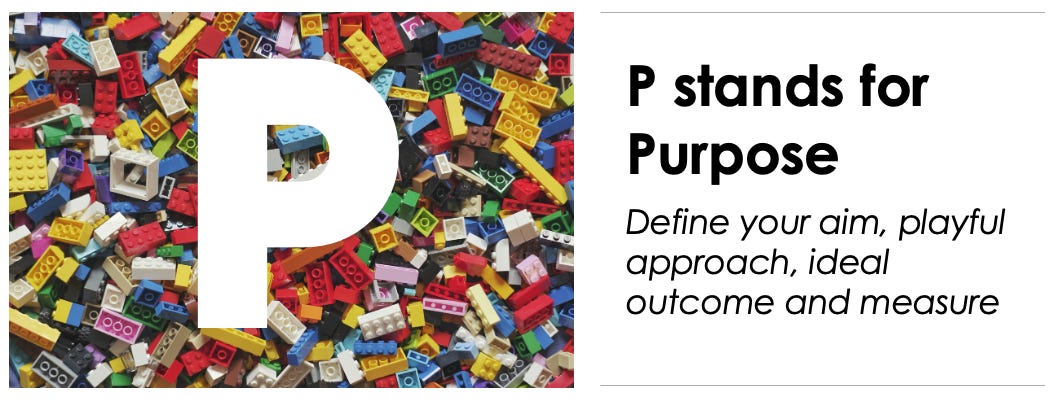PART 4: Design for Play: New Approaches for AI-Curious L&D Teams
A 4-part series exploring the use of play, playful techniques and AI for learning designers and Learning & Development teams
Links to the series: Part 1: The Science of Play and Playfulness in Adult Learning, Part 2: Modern Applications of AI in Adult Learning: The State of Play in L&D, Part 3: 12 Approaches for Designing Play with AI, and Part 4: P.L.A.Y. Build Framework
Photos by Xavi Cabrera on Unsplash, Luke Jones on Unsplash, and Alex Guillaume on Unsplash
Part 4: P.L.A.Y. Build Framework
Integrating AI and play into adult learning requires thoughtful design -- not simply adding game elements, but creating cohesive experiences that are both fun and effective. The P.L.A.Y. Build Framework offers a structured approach:
Start by clarifying the specific learning objectives and business goals your playful learning initiative will address. Every game mechanic, AI interaction, or playful activity should directly support these goals.
Effective purpose-driven design includes:
Aligning play with business outcomes: Clearly articulate how the playful learning experience will improve performance metrics that matter to the organization. For example, a customer service game should measurably improve customer satisfaction scores.
Establishing clear learning objectives: Define what specific knowledge or skills learners should gain. These objectives guide the design of challenges, feedback mechanisms, and progression paths.
Creating meaningful play: Ensure that game mechanics reinforce real-world applications. For example, if negotiation skills are the goal, design role-playing scenarios where AI counterparts respond realistically to different negotiation tactics.
Balancing fun and function: The most effective learning games find the sweet spot where enjoyment enhances rather than distracts from learning objectives. AI can help maintain this balance by adjusting game elements based on learning progress.
When purpose drives design, learners understand why they're engaging with the content and how it connects to their professional development and organizational success.
The "Leverage" component focuses on maximizing existing resources, data, and technologies to create effective playful learning experiences.
Leveraging business goals and KPIs
When designing playful learning experiences, align them with specific business objectives:
Map learning activities to KPIs: Design games and simulations that develop skills directly tied to key performance indicators. For example, if increasing sales is a KPI, create role-playing scenarios where learners practice overcoming common customer objections.
Incorporate real business challenges: Use actual business problems as the foundation for learning games. This makes the experience immediately relevant and provides practice on issues that impact the organization.
Create feedback loops with business metrics: Design systems where learning performance data can be correlated with business outcomes, allowing organizations to see the direct impact of training initiatives.
Leveraging AI and data
AI offers powerful ways to enhance playful learning:
Use historical performance data: Train AI systems on past performance data to identify skill gaps and personalize learning experiences accordingly. For example, an AI might analyze that a particular team struggles with project timelines and generate customized project management scenarios.
Implement predictive analytics: Use AI to forecast which skills will be most valuable based on business trends, allowing organizations to proactively develop those capabilities through targeted playful learning.
Deploy AI for workflow analysis: AI can identify inefficient processes or skill gaps by analyzing workflow data, then generate tailored learning scenarios that address those specific issues.
Leveraging AI agents
As organizations deploy AI agents for various business functions, these same agents can enhance learning:
AI agents as learning partners: AI assistants used for daily work can double as learning coaches, offering just-in-time training when they detect hesitation or errors.
Simulation of stakeholder interactions: AI can roleplay as customers, colleagues, or partners in learning scenarios, providing realistic practice opportunities without real-world stakes.
Personalized learning companions: AI agents can develop an understanding of each learner's strengths, weaknesses, and preferences, then customize challenges and feedback accordingly.
Leveraging real-life use cases
Authentic scenarios increase engagement and transfer of learning:
Sales and revenue data: Use actual sales data to create realistic customer scenarios, allowing salespeople to practice with accurate customer profiles and common situations.
Production and quality metrics: Create games where operations staff solve real problems that have affected production or quality, making the learning immediately applicable.
Customer feedback: Transform actual customer feedback into scenarios where service staff can practice addressing common concerns or complaints.
The "Activate" phase focuses on bringing playful learning experiences to life in ways that engage learners and drive participation. And activation means more than announcing a course’s availability of placing your recorded webinar in your learning system.
Key activation strategies include:
Creating compelling narratives: Frame learning experiences within engaging stories that motivate continued participation. AI can help generate personalized narratives that adapt based on learner choices and performance.
Designing progressive challenges: Structure learning activities with increasing difficulty levels that match the learner's growing skills. AI can dynamically adjust challenge levels to maintain the optimal state of flow.
Implementing meaningful rewards: Design recognition systems that celebrate achievement and progress. These might include digital badges, leaderboards, or even real-world recognition tied to professional advancement.
Facilitating social learning: Create opportunities for collaboration, friendly competition, and knowledge sharing. AI can match learners with complementary skills for team challenges or moderate discussions to ensure everyone contributes.
Providing immediate feedback: Use AI to deliver personalized, constructive feedback that helps learners improve. This feedback should feel supportive rather than judgmental, encouraging continued engagement.
Creating safe practice environments: Design low-stakes scenarios where learners can experiment without fear of failure. AI can simulate realistic consequences of decisions without real-world repercussions.
Using multi-modal learning: Engage different learning styles through varied activities - visual simulations, interactive dialogues, puzzle-solving, etc. AI can identify which modes are most effective for each learner and emphasize those approaches.
The final component of the P.L.A.Y. Operations Framework focuses on measuring outcomes and ensuring return on investment.
Quantitative benefits
Effective playful learning initiatives should demonstrate measurable improvements:
Learning metrics: Track completion rates, assessment scores, time-to-mastery, and knowledge retention. AI analytics can identify patterns and correlations that human analysis might miss.
Performance indicators: Measure changes in job performance before and after training. For example, track sales conversion rates, customer satisfaction scores, or error rates.
Business impact: Calculate ROI by comparing training costs against performance improvements. This might include increased revenue, reduced errors, faster onboarding, or decreased turnover.
Engagement analytics: Monitor participation rates, time spent in learning activities, and learner satisfaction scores. These indicators help predict long-term adoption and effectiveness.
Social learning measurements
Playful approaches often enhance social learning, which brings additional benefits:
Collaboration metrics: Measure increases in cross-functional collaboration, knowledge sharing, and team problem-solving capabilities.
Network analysis: Use AI to map communication patterns and knowledge flows before and after playful learning initiatives, identifying improvements in organizational connectivity.
Community building: Track the formation and activity of communities of practice that emerge from collaborative learning experiences.
Analytics approaches
A comprehensive analytics strategy includes multiple layers:
Descriptive analytics: Collect and report on what happened during learning experiences - who participated, completion rates, scores, etc.
Diagnostic analytics: Determine why certain outcomes occurred. For example, why did one team outperform others in a simulation? What factors predicted success?
Predictive analytics: Use AI to forecast future performance based on learning data. Which employees are likely to excel in particular roles based on their learning patterns?
Prescriptive analytics: Generate recommendations for improving both the learning experience and business performance based on data insights.
By implementing the full P.L.A.Y. Build Framework, learning designers can create AI-enhanced playful learning experiences that engage adult learners, develop critical skills effectively, and demonstrate clear business value.
Conclusion
The science of play in adult learning makes a compelling case that how we learn is just as important as what we learn. By infusing playfulness into training, adults become more engaged, collaborative, and innovative learners.
That’s the hope, and certainly the availability of more and more AI tools may make this a more practical way to explore, experiment and yes, play around.
When we bolster these playful experiences with AI -- making them smarter, more personalized, and scalable -- we have the ingredients for a learning revolution in the corporate world. Organizations should strategically adopt these methods, guided by evidence and best practices, to cultivate a workforce that learns dynamically and joyfully.
The result will be not only better learning outcomes, such as improved memory retention, creativity, and problem-solving, but also a more motivated and adaptable workforce ready to thrive in the fast-changing landscape of the tech industry and beyond.
Let Play and Playfulness be a bold new approach for your L&D strategy. Build your plan!
Links to the series: Part 1: The Science and Strategy, Part 2: Modern Applications of AI in Adult Learning: The State of Play in L&D, Part 3: 12 Approaches for Designing Play with AI, and Part 4: P.L.A.Y. Build Framework
Acknowledging leveraging Perplexity, Gemini, ChatGPT, and Claude for research, formatting, testing links, challenging assumptions and aiding the creative process.
The views and opinions expressed in this article are solely those of the author and do not necessarily reflect the views of the author’s employer or any affiliated organizations.
LICENSING
Unless otherwise noted, the contents of this series are licensed under the Creative Commons Attribution 4.0 International license.
Should you choose to exercise any of the 5R permissions granted you under the Creative Commons Attribution 4.0 license, please attribute me in accordance with CC's best practices for attribution.
If you would like to attribute me differently or use my work under different terms, contact me at https://www.linkedin.com/in/marcsramos/.
NOTES
[11] Christian, D. S. (n.d.). Learning from the Living [Class] Room -- A powerful vision by Daniel S. Christian. Retrieved from http://danielschristian.com/thelivingclassroom/quotes.htm#:~:text=%2A%20AI,discussions%20%26%20collaborative%20project%20work
[12] Christian, D. S. (n.d.). Learning from the Living [Class] Room -- A powerful vision by Daniel S. Christian. Retrieved from http://danielschristian.com/thelivingclassroom/quotes.htm#:~:text=,foster%20collective%20learning%20and%20innovation
[13] Christian, D. S. (n.d.). Learning from the Living [Class] Room -- A powerful vision by Daniel S. Christian. Retrieved from http://danielschristian.com/thelivingclassroom/quotes.htm#:~:text=performance%20data%20to%20create%20optimised,learning%20cohorts
[14] Christian, D. S. (n.d.). Learning from the Living [Class] Room -- A powerful vision by Daniel S. Christian. Retrieved from http://danielschristian.com/thelivingclassroom/quotes.htm#:~:text=create%20and%20connect%20diverse%20groups
[15] Christian, D. S. (2024, January 14). Your classmate could be an AI student at this Michigan university [Frick] + other AI in our Learning Ecosystems. Retrieved from http://danielschristian.com/learning-ecosystems/2024/01/14/your-classmate-could-be-an-ai-student-at-this-michigan-university-frick-other-ai-in-our-learning-ecosystems/#:~:text=experiences%3F%20%E2%80%A6%20TL%3BDR%3A%20while%20personalised,Personalised%E2%80%9D%20Learning
[16] PMC. (n.d.). Leveraging Micro-Stories to Build Engagement, Inclusion, and Neural Networking in Immunology Education. Retrieved from https://pmc.ncbi.nlm.nih.gov/articles/PMC6893969/#:~:text=Abstract
[17] Christian, D. S. (n.d.). Learning from the Living [Class] Room -- A powerful vision by Daniel S. Christian. Retrieved from http://danielschristian.com/thelivingclassroom/quotes.htm#:~:text=AI
[18] Christian, D. S. (n.d.). Learning from the Living [Class] Room -- A powerful vision by Daniel S. Christian. Retrieved from http://danielschristian.com/thelivingclassroom/quotes.htm#:~:text=,and%20guide%20learners%20through%20them
[19] Hardman, P. (n.d.). A Post-AI Learning Taxonomy - by Dr Philippa Hardman. Retrieved from https://drphilippahardman.substack.com/p/a-post-ai-learning-taxonomy#:~:text=Hardman%20drphilippahardman,of%20experimentation%20and%20innovation
ADDITIONAL SOURCES (ALL 4 PARTS)
Bakker, A. B., & Demerouti, E. (2017). Job demands–resources theory: Taking stock and looking forward. Journal of Occupational Health Psychology, 22(3), 273-285.
Brown, S. L., & Vaughan, C. C. (2009). Play: How it shapes the brain, opens the imagination, and invigorates the soul. Avery.
Cross, R., Rebele, R., & Grant, A. (2016). Collaborative overload. Harvard Business Review, 94(1), 74-79.
Csikszentmihalyi, M. (2014). Flow and the foundations of positive psychology: The collected works of Mihaly Csikszentmihalyi. Springer. https://link.springer.com/book/10.1007/978-94-017-9088-8
Deterding, S., Sicart, M., Nacke, L., O'Hara, K., & Dixon, D. (2011). Gamification: Using game-design elements in non-gaming contexts. CHI Extended Abstracts on Human Factors in Computing Systems, 2425-2428. https://dl.acm.org/doi/10.1145/1979742.1979575
Dicheva, D., Dichev, C., Agre, G., & Angelova, G. (2015). Gamification in education: A systematic mapping study. Educational Technology & Society, 18(3), 75-88.
Edmondson, A. C., & Lei, Z. (2014). Psychological safety: The history, renaissance, and future of an interpersonal construct. Annual Review of Organizational Psychology and Organizational Behavior, 1(1), 23-43. https://www.annualreviews.org/doi/abs/10.1146/annurev-orgpsych-031413-091305
Hamari, J., Koivisto, J., & Sarsa, H. (2014). Does gamification work? A literature review of empirical studies on gamification. In Proceedings of the 47th Hawaii international conference on system sciences (pp. 3025-3034). IEEE.
Hardman, P. (n.d.). The AI & Learning Design Bootcamp by Dr Philippa Hardman on Maven | Dr Philippa Hardman. Retrieved from https://www.linkedin.com/posts/dr-philippa-hardman-057851120_the-ai-learning-design-bootcamp-by-dr-philippa-activity-7269375805728686080-03DT
Hardman, P. (n.d.). The Post-AI Educator - by Dr Philippa Hardman. Retrieved from https://drphilippahardman.substack.com/p/the-post-ai-educator
Hertzog, C., Kramer, A. F., Wilson, R. S., & Lindenberger, U. (2008). Enrichment effects on adult cognitive development: Can the functional capacity of older adults be preserved and enhanced? Psychological Science in the Public Interest, 9(1), 1-65. https://journals.sagepub.com/doi/10.1111/j.1539-6053.2009.01034.x
Holmes, W., Bialik, M., & Fadel, C. (2022). Artificial intelligence in education: Promises and implications for teaching and learning. Center for Curriculum Redesign. https://curriculumredesign.org/our-work/artificial-intelligence-in-education/
Kim, S., Song, K., Lockee, B., & Burton, J. (2018). Gamification in learning and education: Enjoy learning like gaming. Springer International Publishing. https://link.springer.com/book/10.1007/978-3-319-47283-6
Knowles, M. S., Holton III, E. F., & Swanson, R. A. (2015). The adult learner: The definitive classic in adult education and human resource development. Routledge.
Mezirow, J. (1997). Transformative learning: Theory to practice. New Directions for Adult and Continuing Education, 1997(74), 5-12. https://onlinelibrary.wiley.com/doi/10.1002/ace.7401
Nembhard, I. M., & Edmondson, A. C. (2006). Making it safe: The effects of leader inclusiveness and professional status on psychological safety and improvement efforts in health care teams. Journal of Organizational Behavior, 27(7), 941-966.
Pentland, A. (2012). The new science of building great teams. Harvard Business Review, 90(4), 60-69.
Pink, D. H. (2011). Drive: The surprising truth about what motivates us. Riverhead Books. http://www.danpink.com/books/drive/
Research AI Multiple. (n.d.). Top 5 Use Cases of Conversational AI in Education in 2025. Retrieved from https://research.aimultiple.com/conversational-ai-in-education/
Roll, I., Butler, D., Yee, N., Welsh, A., Perez, S., Briseno, A., Perkins, K., & Bonn, D. (2018). Understanding the impact of guiding inquiry: The relationship between directive support, student attributes, and transfer of knowledge, attitudes, and behaviours in inquiry learning. Instructional Science, 46(1), 77-104. https://link.springer.com/article/10.1007/s11251-017-9421-5
Stanford d.school. (n.d.). Reflecting with AI | Stanford d.school. Retrieved from https://dschool.stanford.edu/stories/reflecting-with-ai
Texas A&M Stories. (2021, September 6). 5 Reasons Video Games Should Be More Widely Used In School. Retrieved from https://stories.tamu.edu/news/2021/09/06/5-reasons-video-games-should-be-more-widely-used-in-school/
Whitton, N., & Moseley, A. (2014). Deconstructing digital games: Research methods for games studies. Routledge.









